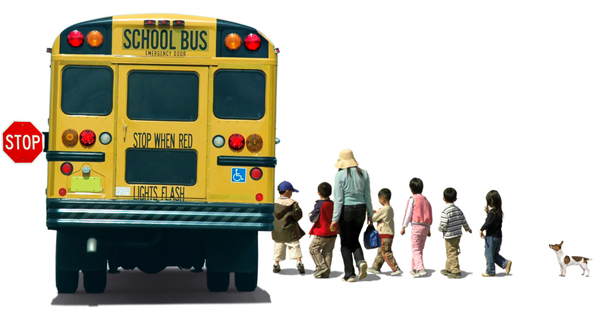After the fun and playtime of summer vacation, fall can be tough on dogs who’ve become used to having the kids around. For some dogs, the household changes that accompany a school-year routine — particularly the absence of family from the house all day — may be distressing, triggering bouts of destructiveness.
If your dog seems stressed about the disruption, there are ways you can minimize his anxiety and soothe him when he is alone:
1. Feed strategically: Give your dog his most substantial meal (and probably a walk) before he’s about to spend his biggest chunk of time alone. Dogs often nap after they eat, so he may snooze away much of his time alone. Another trick is to use food puzzles when you feed your dog. He may be so engaged trying to get to the food that he doesn’t notice everyone leaving.
2. Provide a special chew toy: Have a really good chewy that’s just for his alone time and hand it to him as you and the children leave the house. Similar to feeding your dog his meal using food puzzles, a chew toy is a great way to keep your dog focused on something other than your departure. Just make sure the chew toy is safe to leave with the unattended dog. Stuff a Kong toy with a little peanut butter and let him have at it. Digging out the good stuff will keep your dog busy, relieve him of some of that excess energy and help him over the worst part of his separation from the family — the beginning.
3. Encourage independence at home: Don’t let your dog shadow you at home. All that devotion is wonderful and it feeds our human egos, but it makes matters worse when you leave. If you have a dog who isn’t happy unless some part of him is touching some part of you, encourage his confidence and independence by practicing long “down-stays” (periods of time when he is lying down, and staying down, on command) on the other side of the room every night. Build up to 30 minutes as you watch TV — you on one side of the room, him on the other. Don’t forget to praise him for staying.
4. Add extra exercise to his day: During these transition times, providing opportunities for your dog to burn off extra energy (such as extra walks and more scheduled playtime) can help curb boredom and diminish some of his destructive tendencies.
5. Practice no-fuss comings and goings: A good rule for both you and the children is to keep all entrances and exits low-key. When you leave, calmly tell your dog to “guard the house” or something similar, and give him his special chewy or toy. When you return, tell him to “sit.” Praise him just the tiniest bit and then ignore him completely for the next 10 minutes. You’ll need to be strong and do this for a while until he gets used to the routine. Afterward, you and your children can play with the dog and have some fun.
For some dogs, the problem is not short-term. Some dogs actually suffer long-term separation anxiety and require professional help to overcome the problem. If your dog seems to suffer particularly hard or can’t tolerate being left alone, talk with your veterinarian. He may be able to help or refer you to a trainer or behaviorist to work with your dog. Your vet may also prescribe medication that can help with separation anxiety.
Original Source of Article: Why Back-to-School Time Is the Hardest Time of Year on Dogs









